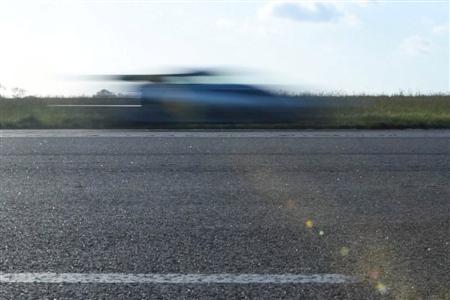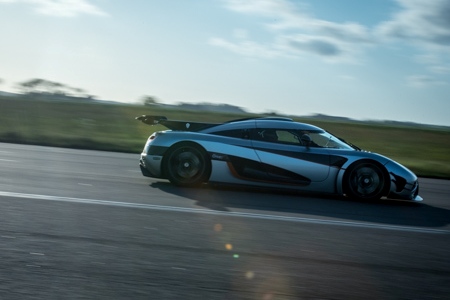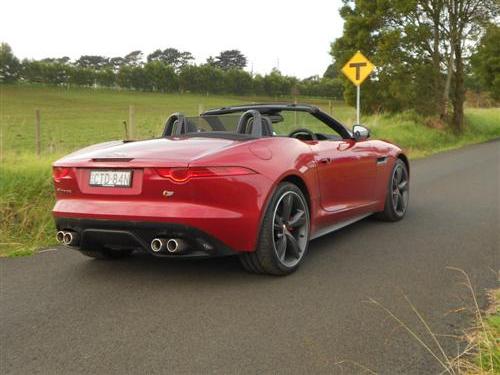|

 Koenigsegg One:1
Koenigsegg One:1
|
|
|
0-300-0 km/h in just 17.95 seconds
Home >
News >
Koenigsegg
Recent new car releases ..... here
Upcoming new car releases ..... here
19th June, 2015
Koenigsegg has outperformed existing production car speed records during a
practice session in the Koenigsegg One:1, headlined by a 0-300-0 km/h time of just 17.95 seconds.
Koenigsegg stunned the world in September 2011 when it set a Guinness World Record time of 21.19 seconds for the
0-300-0 km/h run in the Koenigsegg Agera R. The time achieved by the Koenigsegg One:1 cuts a full 3.24 seconds from what
was already considered to be an unbeatable time.
The record-beating run was one of a series of runs conducted in a practice session at the Koenigsegg test track in
Ängelholm, Sweden. The session was conducted on Monday, 8th June 2015, from 6pm to 10pm. The driver was Koenigsegg
factory test driver, Robert Serwanski.
This session follows recent track testing that revealed impressive performances and unofficial production car lap
records at Suzuka Circuit and Spa-Francorchamps.
Data was collected using the industry standard VBox data recorder.
The stage data for the record beating run is as follows:
0-300 km/h: 11.922 seconds
300-0 km/h: 6.032 seconds
0-300-0 kmh: 17.95 seconds
|
At Next Car
we road test cars!
Check these out!

Jaguar F-TYPE V8 S
road test .....
more

Jaguar XKR-S
road test .....
more
|
|
|
0-200 mph: 14.328 seconds
200-0 mph: 6.384 seconds
0-200-0 mph: 20.71 seconds
It should be noted that this run was just one of many in the four hour session and that faster individual stages, e.g.
0-100 and 100-200, were recorded through the session. In fact, if pieced together all the fastest individual acceleration
and deceleration stages from the day, the theoretical 0-300-0 kmh time would be a staggering 17.49 seconds.
Note, too, that the One:1 development car is about 50kg heavier than customer cars due to the roll cage and other
weight savings that were made to customer cars in series production. The roll cage in the One:1 development car is there
for safety reasons. The development car is thought to have been pushed above and beyond what has been asked of the usual
pre-production car and protection of the driver is paramount.
The roll cage is an option for the One:1 and Agera RS vehicles.
Koenigsegg believe that an even lower time is a distinct possibility with the One:1 and another speed session is
likely in the near future.
Conditions for the 'run'
The Koenigsegg test track is a straight 1.5km runway surface with no gradient along the length of the track. The track
was dry and the 'run' was conducted on 8th June, 2015.
The One:1 was fitted with Michelin Pilot Sport 2 Cup tyres, which are the same tyres fitted to the car upon delivery
to customers.
The air was very calm and virtually wind-free at the time of the run.
|
|
|

Self-Catering Holiday
Accommodation in
Denmark, WA
..... more
|
|
|
How 0-300-0 kmh works
The 0-300-0 run is a test of the vehicle’s mechanical and technical capability. This test is purely designed to see
how quickly the car can accelerate from 0 to 300 km/h and decelerate from 300km/h to 0. It is typically done using two
discrete measurements – acceleration and deceleration – which may be from the same run, or they may be from different
runs within the same session.
For the times announced, both the acceleration time and the deceleration time come from the same run. It is not
unusual, however, to have them sourced from different runs within the same session, which would have resulted in an even
lower number.
Robert, the test driver, does not simply go to 300km/h and then apply the brakes. That would be a test of the driver’s
reaction times rather than a pure test of the vehicle.
Robert accelerates past 300 km/h to 340 km/h and then applies the brakes. This is partly to exceed 200mph, the
measurement of which was a secondary goal in this session, and also to ensure that full brake pressure (both mechanical
and aerodynamic) is in place by the time the car has decelerated to 300 km/h.
E&OE.
|